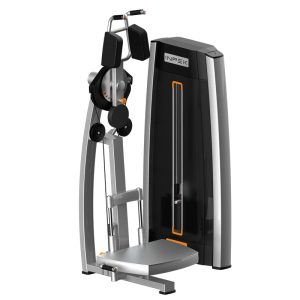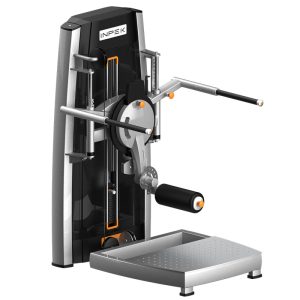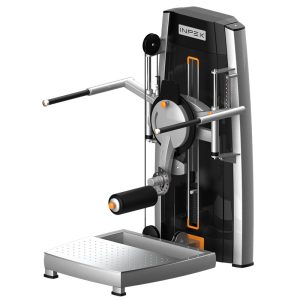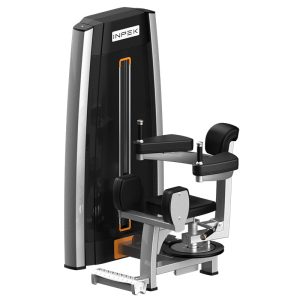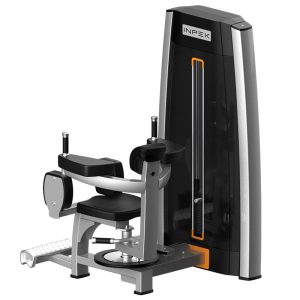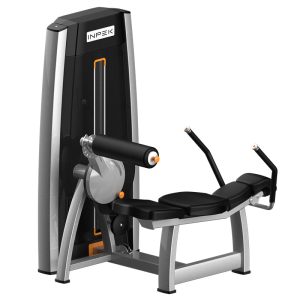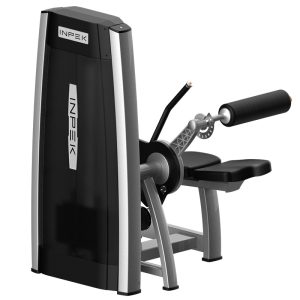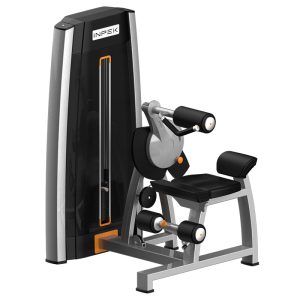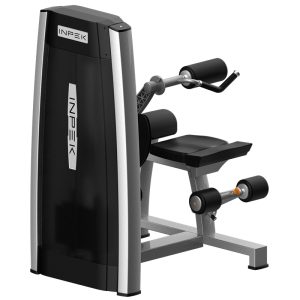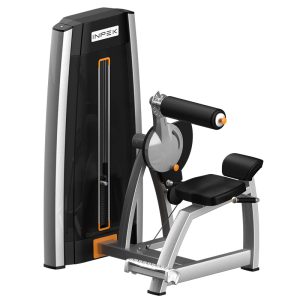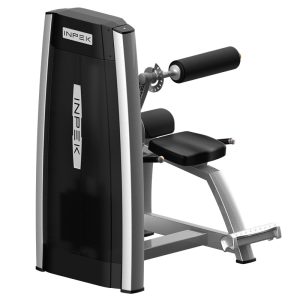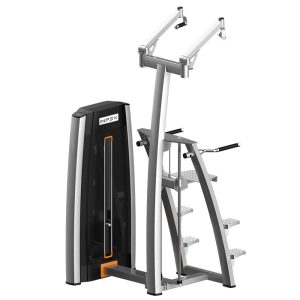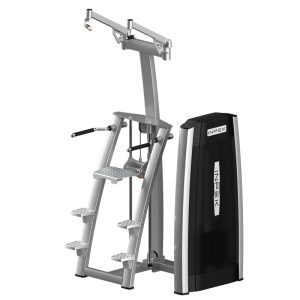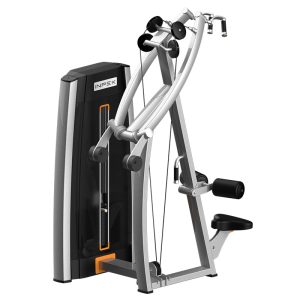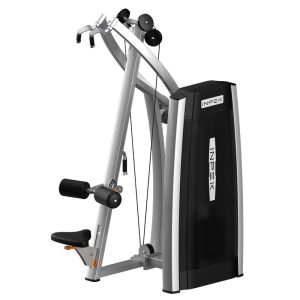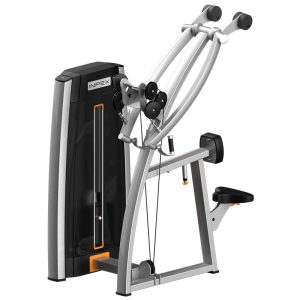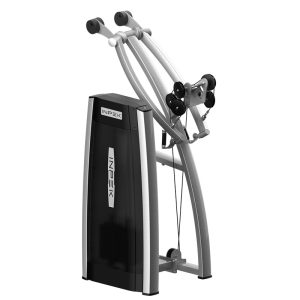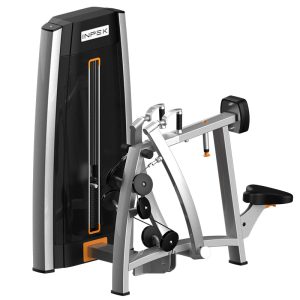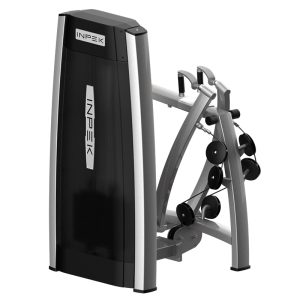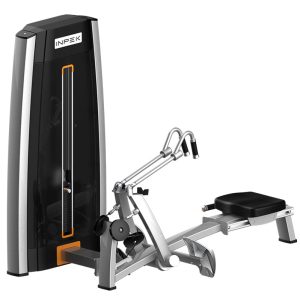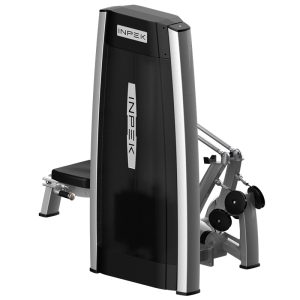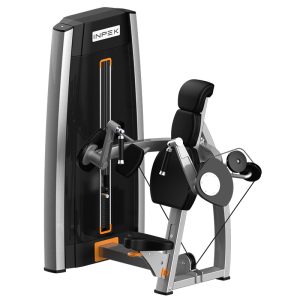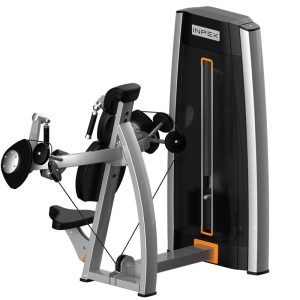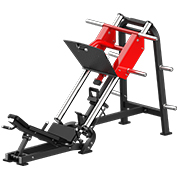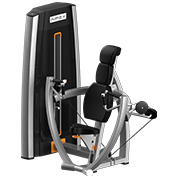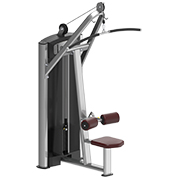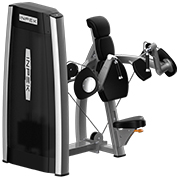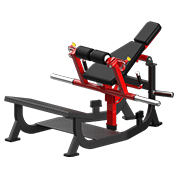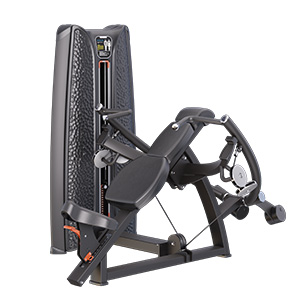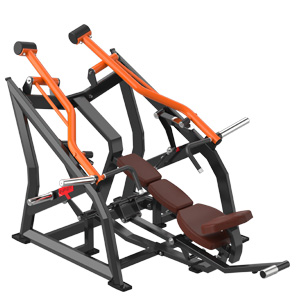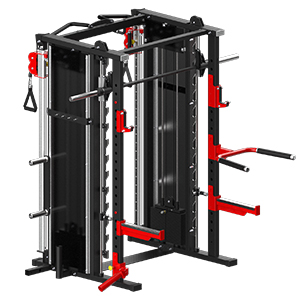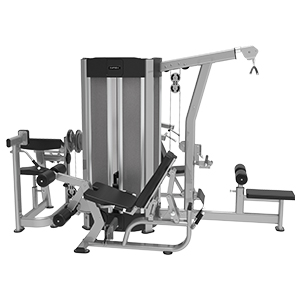Wholesale Shoulder Press Machine | Inpek Fitness
- Home
- /
- Shoulder press machines
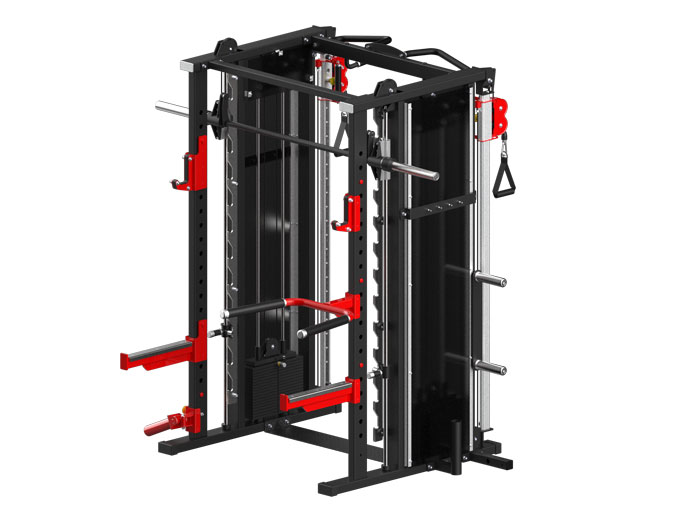
Engineered for optimal performance and accuracy, our shoulder press machines provide the perfect solution for developing strong, well-defined shoulders.Designed to accommodate athletes of all sizes, these machines feature adjustable seat heights, secure rubber feet for stability, and compatibility with Olympic-sized plates. Whether performing incline, overhead, or reverse shoulder presses, you’ll experience controlled, efficient movements that maximize muscle engagement while maintaining proper form. Designed to isolate and sculpt your deltoids, our Shoulder Press machines are perfect for building strong, defined shoulders. Whether you’re looking to build strength, stability, or definition, our Shoulder Press machines provide the stability and control you need for a safe and effective workout.
Our commitment to green innovation and superior manufacturing quality ensures our equipment meets the highest standards of durability and performance, helping you achieve stronger, more defined shoulders and upper body strength with precision and control. Backed by strong R&D and independent innovation, our Shoulder Press machines provide the power, support, and efficiency you need for a powerful upper body workout.

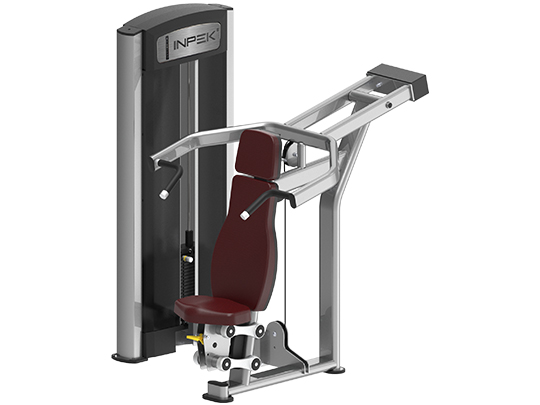
How to Use Shoulder Press Machines Correctly
Using a shoulder press machine correctly is essential for maximizing shoulder strength, preventing injuries, and achieving balanced muscle development. This exercise primarily targets the deltoid muscles, along with secondary activation of the triceps and upper chest. To ensure proper execution, it is important to maintain correct posture, follow the appropriate movement pattern, and avoid common mistakes. Additionally, variations of the shoulder press can help target different muscle groups and improve overall stability. Below is a comprehensive guide on how to use a shoulder press machine effectively.
Correct Posture and Steps
Maintaining the correct posture and executing the shoulder press movement with control ensures optimal muscle engagement and reduces the risk of injury.
Positioning on the Machine
- Sit on the shoulder press machine with your back firmly against the backrest to maintain spinal alignment and prevent excessive lower back strain.
- Place your feet flat on the floor, shoulder-width apart, ensuring a stable base for better force transfer.
- Adjust the seat height so that the handles align with shoulder level—this ensures proper muscle activation and reduces unnecessary strain on the joints.
Incorporating different variations of the shoulder press can help target various muscle groups and improve overall strength and stability. To ensure a safe and effective workout, it’s important to avoid these common errors that can hinder progress or cause injuries. Using a shoulder press machine correctly involves maintaining proper posture, following controlled movement patterns, and avoiding common mistakes. Additionally, incorporating variations such as the seated, standing, and single-arm shoulder press can help target different aspects of shoulder strength and stability. By adhering to these guidelines, you can ensure a safe, effective, and results-driven shoulder workout.Grip and Hand Placement
Performing the Movement
Breathing Technique
Variations of the Shoulder Press Machine
Seated Shoulder Press
Standing Shoulder Press
Single-Arm Shoulder Press
Common Mistakes to Avoid
Arching the Back
Using Momentum Instead of Muscle Control
Overloading with Too Much Weight
Locking the Elbows at Full Extension
What Gym Owners Should Know When Wholesaling Shoulder Press Machines
Wholesaling shoulder press machines for your gym is a crucial investment that requires careful consideration. Gym owners must evaluate factors such as durability, space requirements, customization options, budget, and user feedback to ensure they select the right equipment. The right shoulder gym machines can enhance workout experiences, improve client satisfaction, and contribute to the overall success of a fitness facility. Below is a detailed breakdown of the essential factors gym owners should consider when wholesaling shoulder press machines.
Weight Capacity and Durability – Ensuring Longevity and Safety
A high-quality shoulder press machine must be built to withstand frequent and heavy use. Gym owners should prioritize weight capacity and material durability to ensure both safety and long-term reliability.
- Heavy-Duty Construction: Look for machines made from reinforced steel or high-gauge metal, as these materials offer maximum strength and longevity.
- High Weight Limits: Ensure the machine can accommodate both beginner and advanced lifters, providing progressive resistance without structural compromise.
- Stable Base Design: A sturdy frame with anti-slip footings enhances safety and prevents tipping during heavy lifts.
- Wear-Resistant Components: Opt for machines with high-quality bearings, smooth pulley systems, and thick padding to withstand years of use without frequent maintenance.
By selecting durable shoulder press machines, gym owners can reduce long-term costs associated with repairs and replacements while ensuring a safe lifting experience for members.
Space Requirements – Optimizing Gym Layout
Before purchasing shoulder press machines in bulk, it’s essential to evaluate the available space in your gym. The right equipment should fit seamlessly into your facility without causing congestion.
- Measure Available Floor Space: Consider both the footprint of the machine and the surrounding space needed for users to exercise comfortably.
- Compact and Space-Saving Designs: Some machines are designed with a smaller footprint to fit into tight gym spaces while maintaining full functionality.
- Vertical vs. Horizontal Storage Considerations: Machines with a vertical weight stack can help save space compared to bulkier designs.
- Ease of Movement: If your gym layout frequently changes, machines with built-in transport wheels allow for easy repositioning.
Proper space planning ensures gym members have enough room for safe and effective workouts while maximizing equipment placement for optimal traffic flow.
Customization Options – Aligning with Gym Aesthetics and Functionality
A well-designed gym should provide both functionality and aesthetic appeal. Customization options allow gym owners to tailor shoulder exercises gym machines to their brand identity and member preferences.
- Color Customization: Many manufacturers offer frame and upholstery color choices to match gym branding.
- Adjustable Seat and Handle Positions: Machines with multiple adjustment settings provide better ergonomics and accommodate users of all body types.
- Attachments and Upgrades: Some machines allow for additional grip options, digital tracking systems, or resistance band pegs to enhance workout versatility.
- Branded Logo Placement: Certain manufacturers offer branding customization, allowing gym owners to showcase their logo on the equipment.
Customization not only improves the functionality of the equipment but also enhances the overall atmosphere of the gym, making it more appealing to members.
Budget and Pricing – Balancing Cost and Quality
When wholesaling shoulder press machines, gym owners must find the right balance between cost and quality. Investing wisely ensures long-term value and client satisfaction.
- Compare Different Price Ranges: Machines vary from affordable entry-level options to high-end commercial-grade models—understanding the differences helps in making an informed decision.
- Consider Bulk Purchase Discounts: Many manufacturers offer wholesale pricing incentives, making bulk purchases more cost-effective.
- Check Warranty and Maintenance Costs: A longer warranty period and lower maintenance needs can help reduce overall costs in the long run.
- Financing and Leasing Options: Some suppliers provide payment plans or leasing options, allowing gym owners to invest in high-quality machines without upfront financial strain.
By thoroughly evaluating pricing and budget considerations, gym owners can maximize their return on investment while maintaining high equipment standards.
User Feedback and Reviews – Learning from Other Gym Owners
Before finalizing a purchase, gym owners should research user experiences and feedback from other fitness professionals who have used the machines.
- Check Online Reviews and Testimonials: Platforms like fitness forums, equipment review sites, and manufacturer pages provide valuable insights into the durability and performance of machines.
- Ask for Recommendations from Other Gym Owners: Connecting with industry peers can help identify reliable brands and trusted suppliers.
- Request a Demo or Trial Period: Some suppliers allow gyms to test machines before purchase, ensuring they meet expectations.
- Consider Member Preferences: Machines that receive positive feedback from gym members contribute to higher satisfaction and increased gym retention rates.
Gathering user feedback ensures gym owners invest in equipment that meets both business needs and client expectations.
Selecting the right shoulder press machines for wholesale requires a strategic approach that balances quality, durability, space efficiency, customization, budget, and user satisfaction. By prioritizing high-weight capacity, durable construction, optimal space utilization, and customization options, gym owners can invest in machines that enhance the workout experience while maintaining long-term value. Additionally, considering pricing structures and user feedback ensures that the chosen machines align with both business goals and member expectations.
A well-equipped gym with high-quality shoulder press machines not only attracts new clients but also boosts member retention, ultimately contributing to the success and reputation of the fitness facility.
Seated Shoulder Press Machines vs. Seated Overhead Press Machines
When choosing between a seated shoulder press machine and a seated overhead press machine, it is important to understand how each machine functions, the muscles they target, and their respective benefits. While both machines focus on strengthening the shoulders, their designs and movement mechanics vary, making them more suitable for different training goals and experience levels. Below is a detailed comparison of the two machines to help determine which one is the better option for your workout needs.
Seated Shoulder Press Machine
The seated shoulder press machine is designed for controlled, stable shoulder pressing, making it an excellent choice for those who want to isolate their shoulder muscles while maintaining proper posture.
Design and Functionality
This machine features a seated position with a backrest, ensuring that users maintain spinal support throughout the exercise. The movement follows a fixed pressing path, making it easier to maintain proper form. Most machines also offer adjustable seat heights and weight settings, allowing for progressive overload.
Muscle Activation
The seated shoulder press machine primarily targets the deltoid muscles, particularly the front and lateral portions. It also engages the triceps as secondary movers and activates the upper chest to a lesser extent for added support.
Advantages
One of the biggest benefits of this machine is stability. Since the backrest supports the spine, users can focus on isolating the shoulder muscles without worrying about balance. This makes it ideal for beginners or those recovering from injuries. The fixed movement pattern reduces the risk of improper form, ensuring safe and efficient execution.
Who Should Use It?
This machine is well-suited for beginners, individuals looking for a safe and controlled shoulder exercise, and those who prefer machine-based workouts over free weights. It is also beneficial for those recovering from injuries, as the stability of the machine minimizes strain on the lower back and core.
Seated Overhead Press Machine
The seated overhead press machine offers a more dynamic pressing motion, making it an excellent choice for advanced users who want to engage multiple muscle groups while pressing overhead.
Design and Functionality
Unlike the shoulder press machine, the seated overhead press machine often provides a more natural pressing motion with a greater range of motion. Some models may also lack a backrest, which forces users to engage their core muscles for additional stabilization. The pressing path may be slightly less fixed, allowing for a more functional movement pattern.
Muscle Activation
This machine not only targets the shoulder muscles but also engages the upper back, traps, and core due to the increased stabilization requirements. Additionally, the triceps and upper chest play a supporting role in the movement.
Advantages
One of the primary benefits of the seated overhead press machine is its ability to mimic natural pressing movements that are more functional for everyday activities and sports. It engages more muscle groups than the shoulder press machine, making it a great option for those looking to improve overall upper-body strength. The greater range of motion also allows for better shoulder mobility and flexibility over time.
Who Should Use It?
This machine is better suited for advanced users, athletes, and those looking to build functional strength. Since it requires more core engagement and balance, it is ideal for individuals who want to train for real-world strength applications, rather than strict muscle isolation.
Which is Better?
The decision between these two machines depends on the individual’s fitness level and goals.
For those who are new to shoulder exercises, need extra stability, or prefer a controlled movement, the seated shoulder press machine is the better option. It provides support and minimizes injury risk while still delivering an effective shoulder workout.
For experienced lifters, athletes, or those who want to engage more muscle groups, the seated overhead press machine is the superior choice. Its greater range of motion and emphasis on core stability make it a more functional exercise, translating well into everyday strength and sports performance.
Ultimately, both machines have their place in a well-rounded strength training program, and the best option depends on the individual’s specific training needs and experience level.
How Shoulder Press Machines Help You Achieve Your Fitness Goals
Incorporating a shoulder press machine into your workout routine offers multiple benefits, from building upper body strength to improving muscle definition and athletic performance. Unlike free weights, the shoulder press machine provides a controlled and stable movement, making it suitable for users of all fitness levels. Whether you aim to increase strength, enhance endurance, or achieve a toned physique, this machine can play a key role in reaching your fitness goals. Below is a detailed breakdown of how the shoulder press machine benefits your workout routine.
Builds Upper Body Strength – Developing Power and Muscle Mass
The shoulder press machine is specifically designed to target the deltoid muscles, which are responsible for shoulder movement and stability. Additionally, it engages the triceps and upper chest, contributing to overall upper body strength.
- Primary Muscle Engagement: The deltoid muscles (anterior, lateral, and posterior) are heavily activated, helping to build broader and stronger shoulders.
- Triceps Activation: Since the triceps assist in extending the arms, they get a significant workout during the pressing motion.
- Upper Chest Involvement: The upper portion of the pectoralis major plays a supporting role in the lift, adding strength to pressing movements.
- Progressive Overload Capability: The machine allows for gradual weight increases, making it easier to track progress and continuously challenge the muscles.
By consistently incorporating shoulder press exercises, users can increase overall upper body strength, which translates into improved performance in weightlifting, sports, and daily activities.
Improves Muscle Tone – Achieving a Defined and Sculpted Look
Using the shoulder press machine regularly helps tone and define the shoulder muscles, leading to a more athletic and balanced physique.
- Muscle Definition: Since the deltoid muscles are highly visible, developing them enhances the appearance of broad, sculpted shoulders.
- Balanced Muscle Growth: Unlike some free-weight exercises, the machine ensures equal muscle engagement on both sides, preventing imbalances.
- Higher Training Volume: The controlled nature of the machine allows users to perform more reps without excessive strain, contributing to better muscle endurance and definition.
For individuals looking to improve aesthetics, integrating the shoulder press machine into a regular strength-training routine can enhance muscle tone without excessive bulk.
Enhances Athletic Performance – Strengthening Shoulders for Functional Movements
Shoulder strength plays a crucial role in sports performance and everyday activities. Strong shoulders contribute to better throwing, pushing, and lifting mechanics, making this exercise beneficial for athletes and fitness enthusiasts alike.
- Improved Overhead Strength: Many sports, including basketball, tennis, swimming, and martial arts, require strong shoulders for overhead movements.
- Better Posture and Shoulder Stability: Strengthening the deltoids and surrounding muscles helps maintain proper posture and reduces the risk of shoulder injuries.
- Enhanced Functional Strength: Everyday tasks such as lifting heavy objects, carrying groceries, and pushing movements become easier with stronger shoulders.
Athletes who incorporate shoulder press machines into their training can experience better upper body endurance, power, and injury prevention.
Low-Impact Exercise – Joint-Friendly Strength Training
Unlike free-weight exercises such as barbell or dumbbell shoulder presses, the shoulder press machine provides a controlled, joint-friendly movement, making it ideal for individuals with joint concerns or previous injuries.
- Reduced Risk of Injury: The guided motion prevents excessive strain on the rotator cuff and joints.
- Less Stress on the Lower Back: The seated design provides lumbar support, reducing the risk of lower back discomfort compared to standing free-weight presses.
- Ideal for Rehabilitation: Those recovering from injuries can safely rebuild shoulder strength without the instability of free weights.
For individuals looking for a safe and effective way to train shoulders, especially those with joint sensitivity, the shoulder press machine is an excellent low-impact alternative.
Versatile Workouts – Expanding Training Options
Although the shoulder press machine follows a fixed path of motion, it can still be used for varied training techniques to increase workout effectiveness and muscle engagement.
- Single-Arm Presses: Training one side at a time helps correct muscle imbalances and enhances unilateral strength.
- Paused Reps: Holding the weight at the top or mid-point of the lift increases time under tension, leading to greater muscle activation.
- Drop Sets: Easily adjusting weight allows for intensity-boosting techniques, such as reducing weight after reaching muscle fatigue.
- Superset Pairing: The machine can be paired with other exercises like lat raises or push-ups for a well-rounded shoulder workout.
By incorporating different training variations, users can maximize muscle activation and overall workout effectiveness.
The shoulder press machine is a valuable addition to any fitness routine, offering a safe, effective, and versatile way to build upper body strength, improve muscle tone, and enhance athletic performance. Its low-impact nature makes it accessible for all fitness levels, while its ability to support various training techniques ensures continuous progress.
For gym owners, investing in high-quality shoulder press machines attracts more members, enhances workout options, and contributes to a well-rounded fitness environment. Whether you are a beginner or an experienced lifter, the shoulder press machine is a key tool in achieving stronger, healthier, and more defined shoulders.
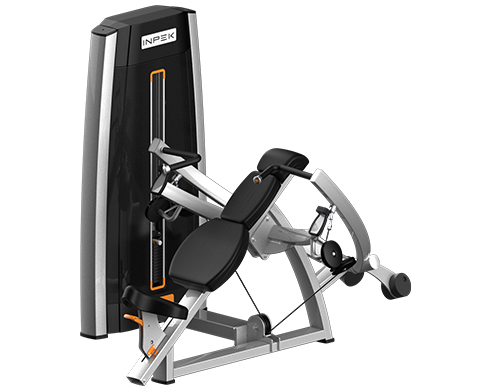
Alternatives to Shoulder Press Machines
While the shoulder press machine is an effective tool for building shoulder strength and muscle definition, incorporating alternative exercises can help improve muscle engagement, increase range of motion, and enhance overall shoulder development. Free weights, cables, and bodyweight movements offer additional benefits, such as greater stabilization and functional strength. Below are some excellent alternatives to the shoulder press machine, each with its own advantages.
Dumbbell Shoulder Press – Greater Range of Motion and Stabilization
The dumbbell shoulder press is a fundamental free-weight exercise that closely mimics the movement of the shoulder press machine but offers a greater range of motion and requires more stabilization.
Muscle Activation: Targets the anterior, lateral, and posterior deltoids, as well as the triceps and upper chest.
Improved Mobility: The independent movement of each dumbbell prevents muscle imbalances and enhances flexibility.
Core Engagement: Since there is no back support, the core muscles must activate to maintain stability throughout the movement.
Variations: Can be performed seated or standing, with single-arm or both arms together, to introduce variety and additional challenges.
The dumbbell shoulder press is ideal for those who want to develop shoulder strength while improving balance, stability, and coordination.
Barbell Overhead Press – Maximum Strength and Power
The barbell overhead press, also known as the standing military press, is a classic strength-training exercise that builds raw power and size in the shoulders.
Heavy Lifting Potential: The barbell allows for greater weight loads, making it excellent for progressive overload and strength gains.
Full-Body Activation: Engages the core, upper chest, triceps, and even the legs, making it a compound movement.
Posture and Shoulder Health: Strengthens the stabilizing muscles around the scapula and rotator cuff, improving overall shoulder stability.
Variation Options: Can be performed seated, standing, or with a push-press motion for added explosiveness.
For lifters focused on strength and athletic performance, the barbell overhead press is one of the most effective alternatives to a shoulder press machine.
Cable Shoulder Press – Adjustable Resistance with Constant Tension
The cable shoulder press provides a smooth and controlled movement while keeping constant tension on the muscles throughout the exercise.
Targeted Muscle Engagement: Works the deltoids, triceps, and stabilizing muscles due to the continuous resistance of the cable system.
Less Joint Stress: The cables provide fluid motion, which reduces strain on the joints compared to free weights.
Customizable Resistance Levels: The weight stack can be adjusted easily, making it ideal for drop sets and progressive overload.
Unilateral Training: Can be performed with one arm at a time, improving muscle imbalances and coordination.
The cable shoulder press is a great alternative for those looking for a controlled, joint-friendly exercise with adjustable resistance.
Push Press – Explosive Power and Athletic Performance
The push press is a dynamic, compound movement that combines elements of the overhead press with leg drive, making it a functional and powerful exercise.
Full-Body Activation: Engages the shoulders, triceps, core, glutes, and legs, making it more than just an upper-body exercise.
Increased Strength and Power: The leg drive allows heavier loads to be lifted, helping develop explosive strength.
Athletic Benefits: Useful for athletes in sports that require overhead movements, such as basketball, football, and Olympic weightlifting.
Variation Options: Can be performed with dumbbells, barbells, or kettlebells to target different muscle groups.
The push press is a fantastic alternative for building strength, power, and athletic performance while engaging multiple muscle groups.
Kettlebell Shoulder Press – Unilateral Strength and Core Stability
The kettlebell shoulder press is a challenging variation that engages not only the shoulders but also the core and stabilizing muscles due to the unique shape and weight distribution of the kettlebell.
Enhanced Shoulder Stability: The offset weight of the kettlebell forces the shoulder stabilizers to work harder, reducing injury risk.
Improved Core Activation: The unilateral nature of the exercise engages the obliques and deep core muscles.
Greater Range of Motion: The kettlebell allows for a natural movement path, promoting better mobility and flexibility.
Single-Sided Strength Development: Helps correct imbalances between the left and right shoulders.
For those looking to challenge their stability, improve mobility, and develop unilateral strength, the kettlebell shoulder press is a unique and effective alternative.
While the shoulder press machine is an excellent tool for developing shoulder strength, incorporating alternative exercises improves overall performance, mobility, and functional strength. Each alternative offers distinct benefits:
Dumbbell Shoulder Press – Enhances stabilization and range of motion.
Barbell Overhead Press – Maximizes strength and power.
Cable Shoulder Press – Provides controlled, constant tension with adjustable resistance.
Push Press – Builds explosive strength and athletic performance.
Kettlebell Shoulder Press – Engages core stability and unilateral strength.
By integrating these exercises into a workout routine, individuals can achieve well-rounded shoulder development, improve functional strength, and reduce the risk of muscle imbalances and injuries.
FAQs About Shoulder Press Machines
Why is the shoulder press machine easier?
The shoulder press machine is easier than free-weight presses because it provides stability and control. Unlike dumbbells or barbells, where you must engage stabilizing muscles to balance the weight, the machine guides your movement along a fixed path, reducing the risk of losing form. Additionally, most machines use pulleys or counterbalanced resistance, making the exercise feel smoother and more controlled. This setup allows you to lift heavier weights without worrying about stabilizing the load, making it ideal for beginners or those recovering from injuries. However, while easier in terms of balance, it may limit functional strength development since stabilizer muscles, such as the rotator cuff and core, are not engaged as much.
What is the best press for shoulders?
The best press for shoulders depends on your goal. If you're aiming for overall shoulder strength and size, the overhead barbell press is the most effective as it engages deltoids, triceps, and upper chest, while also recruiting core stabilizers. For muscle isolation and safety, the shoulder press machine is a great option, allowing controlled movement and easier progression. The dumbbell shoulder press provides a more natural movement pattern and helps correct muscle imbalances, while the push press incorporates leg drive for power and explosiveness. If you want to maximize hypertrophy, incorporating a combination of machine presses, free weights, and isolation movements like lateral raises will give you the best results.
Are shoulder press machines effective?
Yes, shoulder press machines are effective for building shoulder strength and muscle. They target the deltoid muscles (primarily the anterior and medial heads), as well as the triceps and upper chest. The fixed movement pattern ensures proper form, reducing the risk of injury, especially for beginners. Shoulder press machines also allow for progressive overload, making it easier to increase resistance over time. However, they do not engage stabilizer muscles as much as free-weight presses. To maximize shoulder development, combine machine presses with free-weight exercises like dumbbell presses and overhead presses to engage a wider range of muscle fibers.
What are the disadvantages of the shoulder press machine?
While effective, the shoulder press machine has some disadvantages. First, its fixed movement pattern may not match everyone’s natural shoulder mechanics, leading to discomfort or strain over time. Second, it does not engage stabilizing muscles as effectively as free-weight exercises, limiting functional strength development. Additionally, machine presses primarily target the front delts while neglecting the rear delts and rotator cuff muscles, which can create muscle imbalances if not supplemented with other exercises. Lastly, range of motion (ROM) may be limited, preventing full muscle activation compared to free-weight overhead presses.
What happens if I do shoulder press every day?
Doing the shoulder press every day can lead to overuse injuries, muscle fatigue, and potential joint strain. The shoulder muscles, especially the rotator cuff, are delicate and need time to recover. Overtraining them can cause tendonitis, shoulder impingement, or reduced strength over time. Ideally, you should train shoulders 2-3 times per week, incorporating both pressing movements and lateral/rear delt exercises for balanced development. If you want to train shoulders daily, focus on lighter weights, higher reps, and variation to avoid excessive strain. Recovery, proper warm-ups, and mobility work are essential for maintaining shoulder health.
Are shoulder presses bad for your rotator cuff?
Shoulder presses are not inherently bad for the rotator cuff, but poor form, excessive weight, or overuse can lead to rotator cuff strain or injury. The rotator cuff consists of four small muscles that stabilize the shoulder joint, and pressing heavy weights without proper stabilizer engagement can overload these muscles. To protect your rotator cuff, ensure your elbows are slightly in front of your body, avoid locking out your elbows at the top, and use a controlled range of motion. Additionally, supplement with rotator cuff strengthening exercises like external rotations and face pulls.
How many shoulder presses should I do a day?
For optimal results, aim for 3-4 sets of 8-12 reps if your goal is muscle hypertrophy (growth). If training for strength, lower reps (4-6) with heavier weight are recommended. Endurance-focused training can go up to 15-20 reps per set with lighter weight. It’s important to balance volume and intensity with adequate rest and recovery. Training shoulders 2-3 times a week rather than daily will provide better long-term results while minimizing risk of injury.
Why is the shoulder press so much harder?
The shoulder press is harder than other pressing exercises because it primarily relies on smaller muscles—the deltoids—rather than larger muscle groups like the chest. Unlike a bench press, where your back and chest contribute, the shoulder press isolates the delts, making the lift more challenging. Additionally, pressing weight overhead requires more core and stabilizer muscle activation to maintain balance. If using a machine, it might feel easier due to guided movement, but free-weight shoulder presses are generally much harder due to the added need for balance and control.
Is shoulder press or push press better?
The shoulder press is better for muscle hypertrophy and strict strength development, as it isolates the shoulders without momentum. The push press, however, incorporates leg drive, allowing you to lift heavier weights and train for explosiveness and athletic power. If your goal is shoulder size and definition, stick to a strict shoulder press. If you want to develop full-body power and functional strength, the push press is superior. Both movements have value, and incorporating both into your routine can provide well-rounded shoulder development.
What is a good weight for a shoulder press machine?
A good weight depends on your experience level:
- Beginners: Start with 30-50% of body weight, aiming for 12-15 reps per set.
- Intermediate lifters: Use 50-75% of body weight for 8-12 reps.
- Advanced lifters: Can lift 75-100% of body weight for 4-8 reps.
The key is to select a weight that challenges you without sacrificing form. If you can easily complete 15 reps, increase the weight. If you struggle to complete 6 reps with proper form, reduce the weight.
What is the difference between overhead press and shoulder press?
The terms are often used interchangeably, but there are slight differences:
- Overhead Press (OHP): A general term for any pressing movement where weight is pushed overhead, including barbell presses, dumbbell presses, and push presses.
- Shoulder Press: Often refers to a strict overhead press, particularly on a machine or with dumbbells, focusing on isolating the deltoids.
In short, all shoulder presses are overhead presses, but not all overhead presses are strict shoulder presses. The barbell overhead press generally engages more stabilizers, while a shoulder press machine isolates the delts more efficiently.
What Machine Is Used for Shoulder Press?
The most common machine used for a shoulder press is the seated shoulder press machine, which allows users to press weight overhead in a controlled manner. This machine can be either selectorized (weight stack with a pin) or plate-loaded, providing adjustable resistance. Another option is the Smith machine, which provides a guided bar path for a controlled shoulder press. Some cable machines also allow for an overhead press variation by adjusting the pulleys to shoulder height. Additionally, Hammer Strength shoulder press machines offer a plate-loaded design that mimics free-weight pressing while providing more stability. The Arnold press machine and Iso-lateral shoulder press machines target the deltoids from different angles, offering variety in shoulder training. Each machine has unique benefits, but the best choice depends on individual goals, experience level, and gym equipment availability.
What Is the Best Form for the Shoulder Press Machine?
Proper form is essential for maximizing shoulder activation and preventing injury. Start by adjusting the seat so that the handles are at shoulder height when seated. Sit with your back firmly against the pad, feet flat on the floor, and grip the handles with a shoulder-width grip. Keep your core engaged and avoid arching your lower back. Press the handles upward until your arms are almost fully extended, but don’t lock out your elbows. Lower the weight slowly and under control until your elbows are at a 90-degree angle or slightly lower. Avoid shrugging your shoulders or using momentum, as this reduces effectiveness and increases strain. Proper breathing is crucial—inhale while lowering the weight and exhale while pressing up. Maintaining good posture and controlled movement ensures effective muscle activation and minimizes injury risk.
What Is the Difference Between Overhead Shoulder Press and Machine Shoulder Press?
The overhead shoulder press is typically performed with free weights, such as dumbbells or a barbell, while the machine shoulder press provides a guided movement. Free-weight overhead presses engage more stabilizer muscles, including the core, to maintain balance and control. In contrast, the machine shoulder press isolates the deltoid muscles more because the fixed movement pattern removes the need for stabilization. The overhead press allows for a more natural range of motion and is often used in strength training and athletic performance. However, the machine shoulder press is safer for beginners and individuals recovering from injuries, as it reduces the risk of improper form. Both exercises are beneficial, and incorporating both into a workout routine can maximize shoulder strength and development.
What Machine Hits Shoulders?
Several machines effectively target the shoulders:
- Shoulder Press Machine – The primary machine for shoulder development, mimicking an overhead press.
- Smith Machine – Can be used for a guided shoulder press, offering stability while allowing heavier loads.
- Lateral Raise Machine – Specifically targets the side delts, helping with width and roundness.
- Cable Machine – Used for various shoulder exercises, including overhead presses, front raises, and lateral raises.
- Hammer Strength Shoulder Press Machine – Provides an independent arm movement, allowing for a more natural pressing motion.
- Reverse Pec Deck Machine – Primarily targets the rear delts, improving shoulder balance.
Each machine targets different parts of the shoulders, and incorporating multiple machines ensures complete shoulder development.
How to Do Shoulder Press Machine Correctly?
To perform the shoulder press on a machine correctly, adjust the seat height so that the handles align with your shoulders. Sit with a straight back, keep your feet flat on the floor, and grip the handles with a shoulder-width grip. Engage your core and avoid arching your back to maintain stability. Press the handles upward in a controlled motion, stopping just before locking out your elbows. Slowly lower the weight until your elbows reach 90 degrees or slightly lower. Avoid using momentum or shrugging your shoulders. Exhale while pressing up and inhale while lowering the weight. Start with a light weight to master the form before increasing resistance. Performing the movement with proper control ensures maximum shoulder activation while minimizing injury risk.
Is Shoulder Press Machine the Same as Military Press?
No, the shoulder press machine and military press are different exercises. The military press is a strict, free-weight overhead press typically performed with a barbell while standing. It requires more core engagement and full-body stability, making it a compound movement. In contrast, the shoulder press machine provides a guided movement and removes the need for stabilization, focusing more on the deltoid muscles. The military press is more challenging because it involves more muscle groups, including the core and lower body. The machine press is safer for beginners and allows for higher-volume training without worrying about balance. Both exercises have benefits, and incorporating both into a routine can improve overall shoulder strength and development.
Why Do Smith Machines Use Shoulder Press?
The Smith machine shoulder press is popular because it provides stability and safety while allowing for heavy lifting. The fixed bar path eliminates the need for stabilizer muscles, making it easier to focus on pure strength development. This is especially useful for beginners or those recovering from injuries. Additionally, the Smith machine allows for adjustable foot positioning, enabling lifters to reduce lower back strain by keeping their torso slightly leaned back. It also minimizes imbalances between arms, as the barbell follows a controlled trajectory. The downside is that the fixed movement pattern may feel unnatural for some individuals and limit natural shoulder mechanics. However, when used correctly, the Smith machine shoulder press is an excellent alternative to free-weight presses, especially for hypertrophy and controlled strength gains.
What Is the Difference Between Push Press and Shoulder Press?
The push press and shoulder press both involve pressing weight overhead, but they differ in execution. The push press uses leg drive to help generate momentum, allowing lifters to press heavier weights. It’s a more dynamic, full-body movement that engages the legs, core, and shoulders. The shoulder press, especially on a machine, is a strict upper-body movement that isolates the deltoids and does not use leg drive. Because the push press involves explosive power, it is commonly used in athletic training and Olympic lifting. In contrast, the machine shoulder press is better for hypertrophy and muscle isolation. Both exercises have benefits—if the goal is strength and power, the push press is better, while for muscle growth and control, the shoulder press machine is more effective.
How Long Should You Rest Between Sets?
Rest time between sets depends on your training goal:
- For strength (heavy lifting, 4–6 reps) – Rest 2–3 minutes to allow full recovery.
- For hypertrophy (muscle growth, 8–12 reps) – Rest 30–60 seconds to maintain muscle tension.
- For endurance (high reps, 12–15+ reps) – Rest 15–45 seconds for sustained intensity.
For machine shoulder presses, 30–60 seconds is ideal for muscle growth, while longer rest periods allow heavier loads for strength training. Adjust rest times based on your fitness level and recovery needs.
Why Was the Overhead Press Banned?
The overhead press was removed as an official Olympic weightlifting event in 1972 due to concerns about form inconsistencies and safety risks. Unlike the snatch and clean & jerk, which have clear execution rules, lifters began using excessive lean-back techniques, turning the movement into a standing incline press rather than a strict overhead press. This led to spinal hyperextension, increasing the risk of back injuries. Additionally, judging became subjective, as it was difficult to determine whether a lifter maintained proper posture. The sport’s governing body decided to eliminate the overhead press to protect athletes from injury and standardize competition rules. However, the overhead press remains a staple in strength training for developing shoulder and upper body strength. Today, it is widely performed using free weights and machines to build deltoid and pressing power.
Is Shoulder Press Bad for Your Shoulders?
The shoulder press is not inherently bad for your shoulders when performed with proper form and an appropriate weight. However, poor technique, excessive weight, or pre-existing shoulder issues can cause discomfort or injury. Common mistakes include:
- Pressing too far behind the head, increasing shoulder strain.
- Arching the lower back excessively, leading to spinal stress.
- Using momentum instead of controlled movement, reducing effectiveness and increasing injury risk.
To protect your shoulders, ensure that your elbows remain slightly in front of the bar path, press in a natural range of motion, and engage your core for stability. Using a shoulder press machine can be safer for beginners, as it provides a guided path of movement, reducing the risk of improper mechanics. If shoulder discomfort occurs, adjusting grip width, using lighter weight, or incorporating shoulder mobility exercises can help.
How Is Overhead Press Different from Shoulder Press?
The overhead press is typically performed with free weights, such as a barbell or dumbbells, requiring more stability and core engagement. The shoulder press refers more broadly to any pressing movement targeting the shoulders, including machine-based variations. The main differences include:
- Overhead Press (Free Weights)
- Requires core and stabilizer muscle activation.
- Allows for a greater range of motion.
- Can be more challenging due to balance demands.
- Shoulder Press (Machine-Based)
- Follows a fixed movement path, reducing stabilization requirements.
- Isolates the deltoids more effectively.
- Safer for beginners and those recovering from injuries.
Both variations are beneficial, but machine shoulder presses are better for muscle isolation, while overhead presses build overall strength and athletic performance.
Is Behind-the-Neck Shoulder Press Bad?
Yes, the behind-the-neck shoulder press is generally considered risky because it places the shoulders in an unnatural external rotation, increasing the likelihood of rotator cuff strain and joint impingement. This movement can also stress the cervical spine, especially if the bar is lowered too far.
While some advanced lifters perform this exercise safely, it requires excellent shoulder mobility and flexibility. Instead, safer alternatives like the standard shoulder press or Arnold press offer similar benefits without excessive joint stress. If you prefer behind-the-neck pressing, limit the range of motion and use light weights to reduce injury risk.
Is Just Overhead Press Enough?
While the overhead press is an excellent compound movement, it is not enough for complete shoulder development. The shoulders consist of three heads:
- Anterior (front) delts – Primarily worked during overhead presses.
- Lateral (side) delts – Best targeted with lateral raises and upright rows.
- Posterior (rear) delts – Activated through reverse flys and face pulls.
Relying solely on the overhead press may lead to imbalanced shoulder development, emphasizing the front delts while neglecting the side and rear delts. To build well-rounded shoulders, incorporate lateral raises, rear delt flys, and upright rows alongside the press.
How Do You Fail Overhead Press Safely?
Failing safely on an overhead press depends on whether you’re using free weights or a machine:
- Machine Shoulder Press:
- Use a weight you can control to avoid sudden failure.
- If struggling, slowly lower the handles back to the starting position instead of dropping them.
- Barbell Overhead Press:
- If using a rack, step back and let the barbell fall forward onto safety bars.
- If no safety bars are present, lower the bar back to the chest and set it down carefully.
- Never lean back excessively, as this increases spinal strain.
- Dumbbell Shoulder Press:
- If failing, carefully bring the dumbbells down to your shoulders and gently place them on your thighs before lowering.
- Avoid throwing the dumbbells down, which can cause injury.
Using proper spotting techniques and knowing your limits prevents unnecessary injuries.
How to Do Guillotine Press?
The guillotine press is a variation of the bench press where the barbell is lowered to the upper chest/neck area instead of the lower chest. It is not recommended for shoulder press machines, as machine paths are fixed.
To perform the guillotine press:
- Lie on a flat bench and grip the barbell with a slightly wider grip.
- Lower the bar toward the top of the chest or neck, keeping elbows flared.
- Press the bar back up in a controlled manner.
Caution: This exercise puts extreme stress on the shoulders and should only be performed with light weights and by experienced lifters. A safer alternative for shoulder machine users is the high-incline press, which targets similar muscles.
Is Shoulder Press Enough to Build Shoulders?
The shoulder press is essential but not enough for fully developed shoulders. While it strengthens the front delts, it does not effectively target the side and rear delts, which contribute to a balanced, well-rounded look.
To maximize shoulder growth, include:
- Lateral raises (for side delts).
- Face pulls or reverse flys (for rear delts).
- Upright rows (for overall shoulder engagement).
A combination of pressing and isolation exercises is key for balanced development.
Should Shoulder Press Be 90 Degrees or Lower?
A 90-degree angle at the elbows (or slightly lower) is ideal for reducing shoulder strain. Lowering the handles too far can cause shoulder impingement, while stopping too high limits range of motion.
Best practice:
- Lower the handles until your elbows are at 90 degrees or slightly below.
- Avoid extreme depths that strain the rotator cuff.
- Maintain a neutral spine without excessive arching.
If using free weights, a natural range of motion is better than a strict 90-degree stopping point.
What Is the Best Technique for Shoulder Press?
- Adjust the seat so handles are at shoulder height.
- Sit with a straight back, feet flat on the floor.
- Grip the handles with a shoulder-width grip.
- Press up without locking elbows.
- Lower the weight in a controlled manner, stopping at 90 degrees or slightly below.
- Engage the core to prevent back arching.
- Breathe properly—exhale when pressing up, inhale when lowering.
What Is Better Than Shoulder Press?
No single exercise is “better,” but some complementary movements can enhance shoulder growth:
- Arnold Press – Engages more deltoid heads.
- Lateral Raises – Isolate side delts for width.
- Face Pulls – Strengthen rear delts for balance.
- Handstand Push-Ups – Increase bodyweight strength.
For machine users, combining the shoulder press with lateral and rear delt exercises is the best approach for complete shoulder development.
Top 10 high-tech manufacturing hubs
End-to-end integrated manufacturing, fully integrated recycling production line
You see more than just a factory
Intelligent steel pipe production line
Next generation laser cutting technology
Intelligent pipe bending process
Intelligent mechanical welding
New generation spraying process system
Delivering superior quality through pre-assembled solutions
Our Valued Clients







Collaborate with Inpek Fitness Experts for Your Commercial Gym Projects
Looking to enhance your gym with premium equipment? Have inquiries or ideas? Complete the form below to engage with our expert team. We’ll work with you to realize your fitness facility goals efficiently and effectively.


